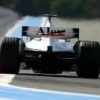Link to full spec and images
Facts and figures:
Output of the BMW P83 is over 900 bhp.
Maximum engine speed is 19,200 rpm.
In a race, engine speed is limited to 19,000 rpm.
Idle speed is 4,000 rpm.
The engine weighs less than 90 kilograms.
The air intake volume is 1,995 cubic metres per hour.
Maximum piston acceleration is 10,000g.
Piston speed peaks at 40 metres per second and averages 25 metres per second.
Exhaust temperatures of up to 950 degrees are reached.
Maximum air temperature in the pneumatic system is 250 degrees.
It completes a distance of 500 kilometres before undergoing revision.
Total production of the BMW P83 is 200 units, ten of which the team takes to each race.
Before being phased out the engine will have received 1,388 upgrade modifications.
It comprises around 5,000 individual components, 1,000 of them different.
The ultra-high-speed 130R turn at Suzuka with its lateral load of 4g poses the greatest challenge to the oil system.
The BMW P83 endured the highest full-throttle proportion on the Monza circuit at 73 per cent per lap.
that 1,950 CAD drawings were made for this engine? Printed out and laid end to end, they would cover a distance of 1.3 kilometres.
























